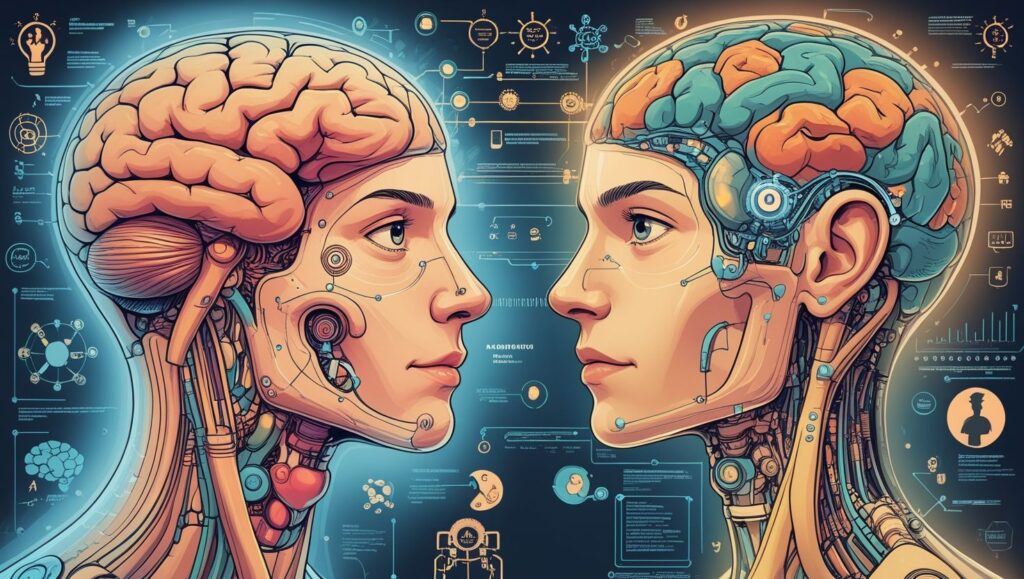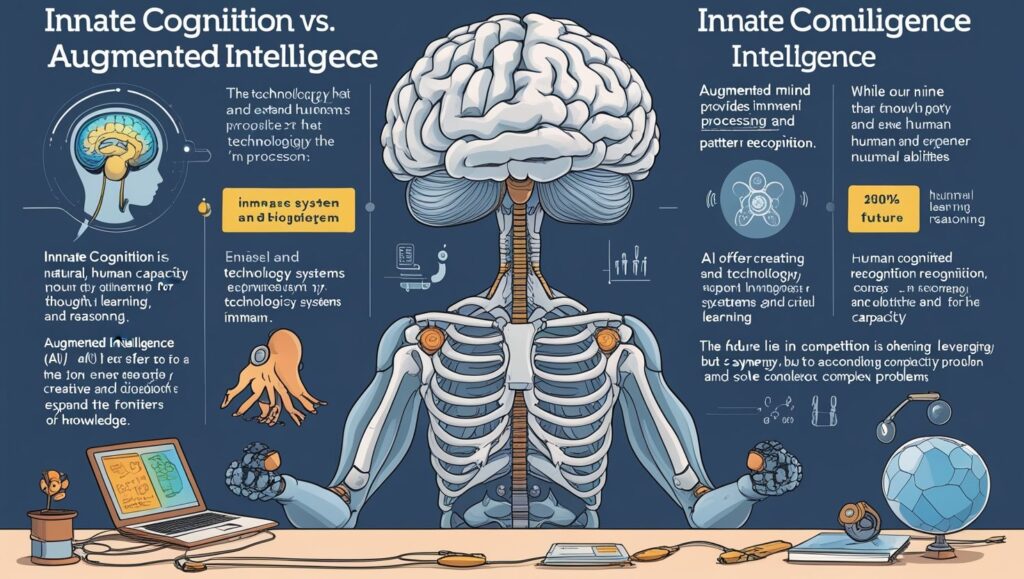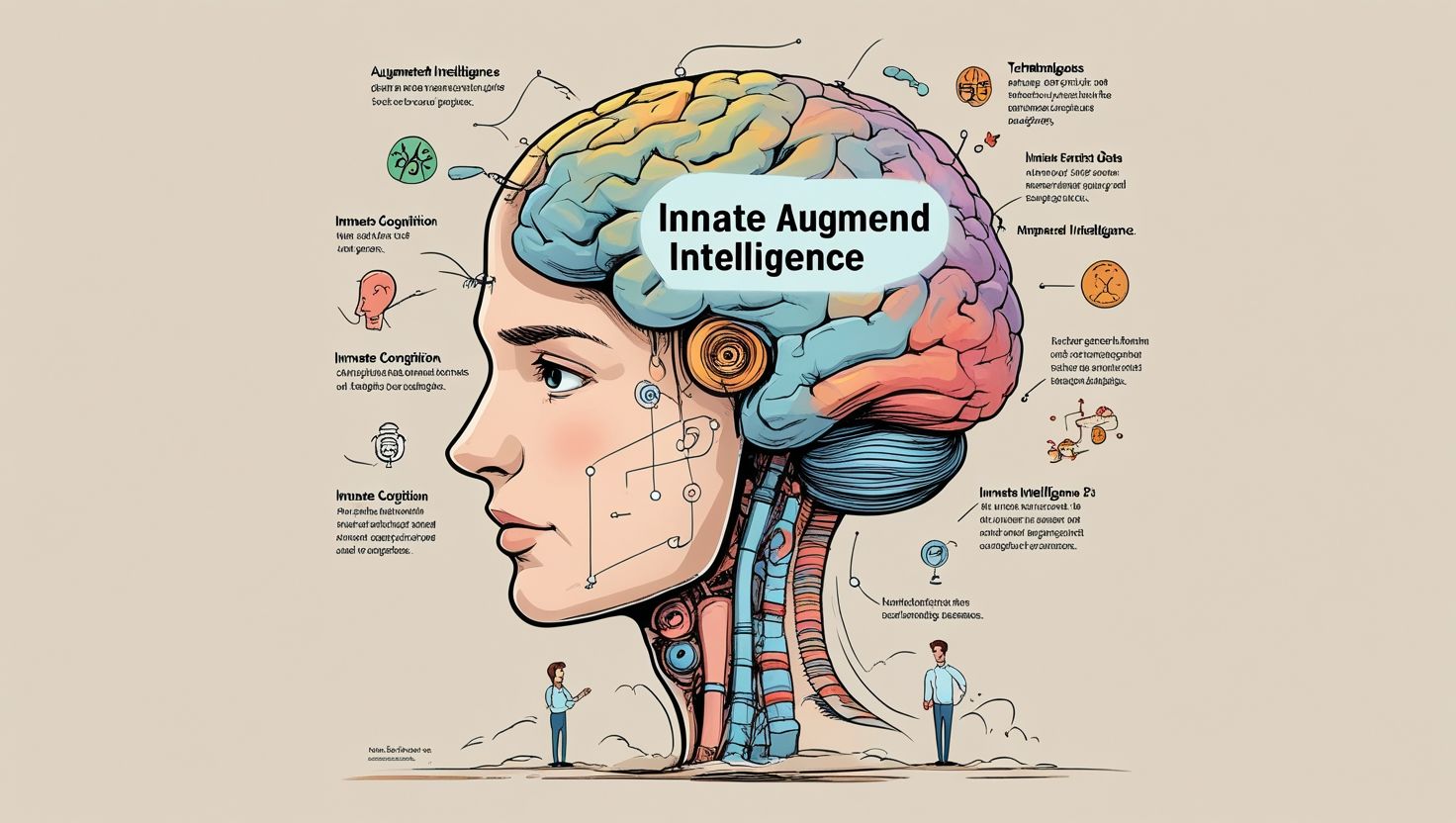Introduction
Innate Cognition vs. Augmented Intelligence, Human learning and intelligence have always fascinated scholars. The debate between innate cognition and augmented intelligence is central to understanding how knowledge develops. The Critical Role of Early Childhood Development further highlights the importance of this discussion. Innate cognition refers to the natural ability of humans to process, interpret, and apply information without external tools. Augmented intelligence, however, represents the collaboration between human thought and artificial systems. Both approaches shape how individuals learn, solve problems, and make decisions. In today’s digital era, this contrast is more relevant than ever. Technology enhances memory, speeds information access, and supports decision-making. Yet, it raises questions about dependence and originality. Education, therefore, must balance natural cognitive growth with supportive digital tools. As children and adults navigate learning, finding this equilibrium becomes crucial. Thus, the comparison between innate cognition and augmented intelligence provides insight into future possibilities of human development.
Understanding Innate Cognition
Innate cognition refers to the natural abilities that humans are born with to process and interpret the world. It is grounded in biology, psychology, and neuroscience. The Critical Role of Early Childhood Development proves that children demonstrate problem-solving and reasoning skills long before formal education begins. These abilities include pattern recognition, spatial awareness, and language acquisition. Innate cognition helps individuals adapt to new situations by relying on instinct and learned experiences. Moreover, it plays a role in moral judgments and social interactions, which are not easily replaced by machines. Although innate cognition is strong, it also has limitations, such as memory overload or biases. Despite these, it remains essential for creativity, innovation, and empathy. Education systems should nurture these natural skills by encouraging exploration, critical thinking, and collaboration. Understanding innate cognition shows why humans possess unique qualities that cannot be fully duplicated by artificial systems.
Defining Augmented Intelligence
Augmented intelligence, sometimes called intelligence amplification, emphasizes collaboration between humans and machines. It focuses on improving, rather than replacing, human decision-making. In this context, The Critical Role of Early Childhood Development reminds us that tools and technologies must enhance natural learning abilities. Augmented intelligence includes technologies like artificial intelligence, machine learning, and advanced analytics. For instance, doctors use AI systems to diagnose illnesses more accurately. Similarly, educators employ digital platforms to assess student progress efficiently. Unlike artificial intelligence, which seeks autonomy, augmented intelligence prioritizes partnership. It empowers humans to make better decisions by providing data-driven insights. Nevertheless, overreliance on digital tools may weaken critical thinking or creativity. Therefore, the balance between dependence and enhancement must be considered. Augmented intelligence is not the future of machines alone but a shared journey between human cognition and technological advancement. Its goal is empowerment, not replacement.

Comparing Cognitive Approaches
The debate between innate cognition and augmented intelligence reflects two different approaches to problem-solving. The Critical Role of Early Childhood Development demonstrates how children use innate skills like reasoning and pattern recognition naturally. However, in today’s world, digital tools extend these abilities. For example, a child may calculate using natural logic but also benefit from digital applications for accuracy. Innate cognition offers adaptability, creativity, and intuition. Augmented intelligence provides efficiency, speed, and access to vast knowledge. Together, they can complement each other. Problems arise when one is valued over the other. Relying only on technology risks diminishing human originality. Depending only on natural cognition may reduce productivity in a complex world. Therefore, balance is key. Educators, researchers, and policymakers must consider how these two approaches can co-exist. Ultimately, both innate cognition and augmented intelligence shape the way humans think, learn, and evolve in modern society.
Education and Innate Cognition
Education plays a key role in nurturing innate cognition. Children naturally learn through exploration, imitation, and interaction. The Critical Role of Early Childhood Development highlights how these innate skills emerge before structured schooling. Teachers can support this by creating environments that encourage problem-solving and critical thinking. Play-based learning allows children to exercise memory, reasoning, and social abilities. Encouraging creativity through drawing, storytelling, and role-play builds imagination. Moreover, innate cognition supports curiosity, which drives lifelong learning. Yet, schools sometimes prioritize rote memorization over natural development. This can limit children’s ability to think independently. Instead, education must balance knowledge delivery with opportunities for cognitive growth. Teachers should guide children to discover solutions, ask questions, and challenge assumptions. When innate cognition is respected in education, students gain confidence and resilience. They learn not just facts but ways of thinking that remain valuable throughout life.
Education and Augmented Intelligence
Innate Cognition vs. Augmented Intelligence, education also benefits from augmented intelligence. Digital tools, applications, and AI platforms transform classrooms globally. The Critical Role of Early Childhood Development suggests that technology should enhance—not replace—natural learning. Augmented intelligence provides personalized learning paths, ensuring each child learns at their own pace. Interactive platforms adapt to strengths and weaknesses, offering targeted support. Teachers can use data-driven insights to monitor progress more effectively. Furthermore, simulations and virtual experiences expose learners to situations they might never encounter otherwise. For example, augmented reality can bring science experiments or history lessons to life. However, risks remain if schools overemphasize digital tools. Children may become passive receivers of information rather than active learners. Therefore, technology must complement, not dominate, education. When applied wisely, augmented intelligence strengthens teaching and fosters deeper learning. It prepares students for a digital world while keeping natural curiosity and critical skills alive.
Social Implications
The interaction between innate cognition and augmented intelligence carries social consequences. The Critical Role of Early Childhood Development underscores how these influences shape communities and future citizens. Innate cognition fosters empathy, cooperation, and moral reasoning. Augmented intelligence, however, expands access to information and global connectivity. Together, they affect communication, relationships, and cultural development. On the positive side, augmented tools provide opportunities for collaboration across borders. Yet, they may also create dependency or widen digital divides. Those without access to technology may fall behind, even if their innate cognition is strong. Moreover, social skills may weaken if overreliance on machines replaces human interaction. To maintain balance, societies must prioritize digital literacy, ethical awareness, and inclusion. By integrating both natural skills and technological tools responsibly, communities can thrive. The goal is not replacing human thinking but amplifying it to build stronger, fairer societies.
Workplace Applications
In workplaces, innate cognition and augmented intelligence collaborate constantly. The Critical Role of Early Childhood Development reflects how skills developed early influence professional success. Innate cognition supports creativity, intuition, and decision-making under uncertainty. Augmented intelligence, on the other hand, strengthens productivity, precision, and data analysis. For example, designers rely on creativity but use digital tools for modeling. Doctors apply clinical judgment but benefit from AI-assisted diagnostics. Both aspects must coexist for efficiency and innovation. However, challenges emerge when automation replaces human workers or reduces critical involvement. Professionals risk losing skills if machines dominate tasks. Therefore, training programs must emphasize lifelong learning, adaptability, and technology integration. Successful workplaces value both natural problem-solving and advanced tools. By blending innate cognition with augmented intelligence, organizations gain innovation and competitiveness. Ultimately, workplaces that balance these elements prepare individuals for sustainable growth in an ever-changing environment.
Challenges and Risks
The integration of innate cognition and augmented intelligence is not without difficulties. The Critical Role of Early Childhood Development highlights risks when one aspect is ignored. Overreliance on augmented tools may lead to weakened memory, attention, or creativity. Children who rely too heavily on digital devices may struggle with independent thinking. On the other hand, resisting technology entirely may hinder competitiveness in modern life. Another challenge involves ethical concerns. Who controls the data produced by augmented systems? Bias in algorithms can also influence decision-making. Additionally, unequal access to technology creates educational and social gaps. Teachers and parents face difficulties balancing screen time with natural learning. Workplaces struggle to retrain employees for digital transformation. Addressing these challenges requires awareness, ethical regulation, and responsible innovation. By confronting these risks directly, societies can ensure that innate cognition and augmented intelligence coexist without diminishing human potential. Innate Cognition vs. Augmented Intelligence is very important in this regards.

Future Directions
Looking forward, innate cognition and augmented intelligence will remain interconnected. The Critical Role of Early Childhood Development indicates that children must be prepared for a world where both skills matter. Education systems will likely blend natural learning with digital support. Lifelong learning will become essential as technologies evolve. Personalized platforms will guide learners while teachers nurture innate curiosity. In workplaces, humans and machines will collaborate on problem-solving, combining creativity with precision. Ethical frameworks will ensure responsible use of augmented tools. Moreover, inclusivity will remain vital, ensuring no one is left behind. By integrating innate cognition with technological support, future societies may achieve unprecedented progress. However, balance remains the key. Humans must continue valuing empathy, creativity, and moral reasoning while embracing innovation. The future depends on both natural strengths and digital tools working together for growth, equity, and sustainability.
Conclusion
Innate Cognition vs. Augmented Intelligence, the comparison between innate cognition and augmented intelligence is essential for understanding learning and development. The Critical Role of Early Childhood Development reminds us that both aspects shape children and adults in unique ways. Innate cognition emphasizes natural reasoning, creativity, and adaptability. Augmented intelligence, on the other hand, enhances these strengths with efficiency, data, and precision. Yet, both approaches face risks if applied in isolation. Education, society, and workplaces must balance them thoughtfully. By integrating natural skills with supportive tools, individuals can thrive in an increasingly digital world. Ultimately, innate cognition and augmented intelligence are not rivals but partners. Their collaboration empowers humanity to solve problems, innovate, and grow ethically. Therefore, the future depends on nurturing human potential while responsibly embracing technological advancements. This partnership ensures a world where intelligence—both natural and augmented—serves the well-being of all.
References
- Chomsky, N. (1980). Rules and Representations. Columbia University Press.
- Clark, A. (2003). Natural-Born Cyborgs: Minds, Technologies, and the Future of Human Intelligence. Oxford University Press.
- Kahneman, D. (2011). Thinking, Fast and Slow. Farrar, Straus and Giroux.
- Russell, S., & Norvig, P. (2016). Artificial Intelligence: A Modern Approach. Pearson.
- UNESCO. (2019). Artificial Intelligence in Education: Challenges and Opportunities. UNESCO Publishing.

Usually I do not read article on blogs however I would like to say that this writeup very compelled me to take a look at and do so Your writing taste has been amazed me Thanks quite nice post
Excellent work on this ultimate guide! every paragraph is packed with value. It’s obvious a lot of research and love went into this piece. If your readers want to put these 7 steps into action immediately, we’d be honoured to help: https://meinestadtkleinanzeigen.de/ – Germany’s fastest-growing kleinanzeigen & directory hub. • 100 % free listings • Auto-sync to 50+ local citation partners • Instant push to Google Maps data layer Drop your company profile today and watch the local calls start rolling in. Keep inspiring, and thanks again for raising the bar for German SEO content!